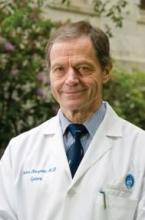When parents say their child stopped breathing for a few seconds, suddenly fell to the floor, or sometimes stares off into space, you might immediately think "epilepsy." But several conditions can trigger these events and should be included in your differential diagnosis.
Breath-holding spells, staring off, and gastroesophageal reflux are probably the most common conditions that can mimic epilepsy, but there are many others. Awareness of all the possible etiologies is important because pediatricians are on the front line for diagnosis and initial management of these patients.
Begin by asking for a very detailed description of the spells, including circumstances, timing, and any triggers. Even neurologists who specialize in epilepsy may not spend enough time getting a very, very precise description from the patient and witnesses. Take a thorough medical history of the patient and family to narrow down your differential possibilities. Combined, this information will foster an accurate diagnosis or determine which tests or referrals are indicated.
Depending on your initial assessment, consider blood tests for glucose, calcium, electrolytes, and thyroid function. In some cases, a toxic screen also is appropriate. ECGs and EEGs can be diagnostic as well, although not every pediatrician’s office has these capabilities. It also may be appropriate to refer for polysomnography if you suspect a sleep disorder, including apnea.
In contrast, a CT scan is rarely helpful and in general should not be ordered for these patients. If epilepsy remains a consideration, a head MRI is the more appropriate test.
Because only rarely will you witness a spell in your office, you have to rely on patient and caregiver reports. A useful tip is to ask parents for a video of the event. This is very feasible given the widespread use of smart phones.
Most pediatricians feel comfortable managing the patient with breath-holding spells, tics (including those associated with Tourette syndrome), self-stimulatory behavior, head banging, and night terrors. In contrast, a specialist referral might be appropriate for the child with more severe gastroesophageal reflux, opsoclonus (rapid and irregular eye movements), or one of the psychiatric disorders with manifestations that can mimic epileptic seizures.
Do not hesitate to refer if you remain at all unsure after going through your differential diagnosis. Most pediatricians appropriately refer children to me for further evaluation; only infrequently do I assess a child who obviously does not have epilepsy.
Within the following broad categories are some specific conditions and potential concerns:
• Unusual movements. Newborns can experience seizures, jitteriness, and nonepileptic jerks. Benign sleep myoclonus is very common but parents may come in concerned about these jerky movements. Tics (including motor and vocal tics that characterize Tourette syndrome) can look like seizures. Tics also can point to epileptic myoclonus, in which case further evaluation with EEG is warranted.
Paroxysmal torticollis or head turning in infants is generally benign and well within the purview of pediatricians to diagnose and manage. Different eye movement disorders occur both with and without seizures as well. Be more concerned if you see opsoclonus or "dancing eyes," because you may need to rule out neuroblastoma.
"Paroxysmal kinesigenic dyskinesia" is a good example of a condition that can mimic epilepsy. The characteristic unusual writhing of extremities that is triggered by movement (such as rising from a chair) is a relatively rare condition.
Self-stimulatory behavior also is commonly mistaken for seizures. Typically children place their hands between their thighs, thrust their pelvis back and forth, and then after a few minutes fall asleep. Some refer to this behavior as "infantile masturbation.’"
• Loss of tone or consciousness. Syncope or fainting spells are common and can appear similar to seizures as well.
The typical loss of consciousness presentation is orthostatic. These patients reliably will say that they faint upon standing.
Occasionally, you may hear about patients whose knees buckle and they fall, right after a surge of negative emotion such anger. This is called cataplexy, and it’s one of the symptoms of narcolepsy; it is not epilepsy.
Hemiplegia and certain migraines can mimic seizures as well, so keep these in mind with your differential diagnosis.
You are more likely to hear reports about children who "stare off" for minutes at a time. If you hyperventilate a child in your office and this triggers a staring spell, the child might have absence seizures. In contrast, these spells are less concerning if parents report they can get the child’s attention during the staring. So, as part of your differential, ask parents if they can get the child’s attention during one of these spells. Another tip is to test recall: Instruct the parents to tell the child to remember a specific color and number during the spell; if the child can recall the information a few minutes later, this helps to rule out absence seizures.


